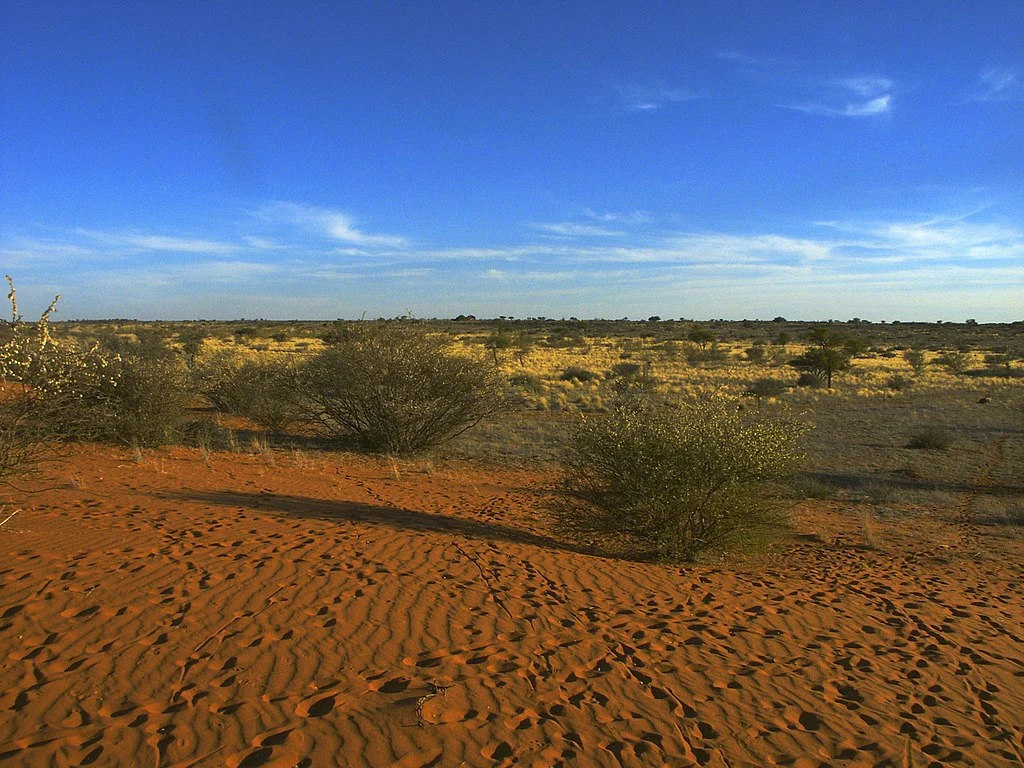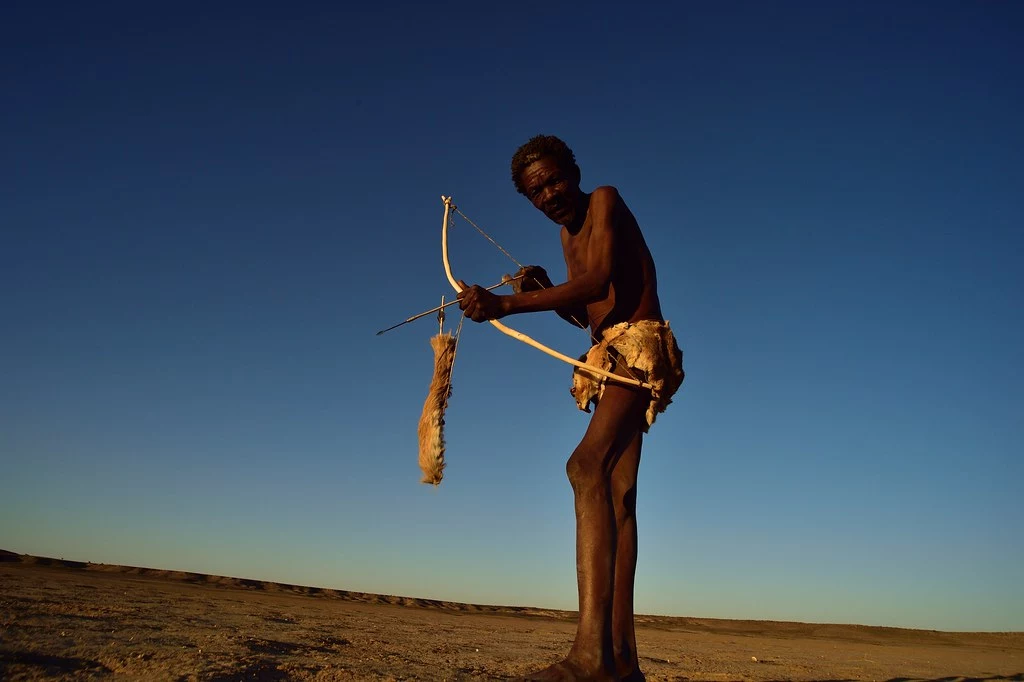The word Kalahari is derived from the Tswana word Kgala which means “the great thirst” or Kgalagadi which means “a waterless place”. The vast Kalahari sand overlies the rainwater, leaving the surface dry.
Kalahari Desert has existed from 65 to 150 million years ago. It’s home to the Bantu speakers and Kalahari Bushmen, also known as San, who speak a language called Khoisan and have lived there for approximately 20,000 years as hunters and gatherers. A few Europeans also live in some parts of the desert since the 1890s.
The Kalahari Desert is a large semi-arid sandy savannah in Southern Africa that covers much of Botswana and parts of Namibia and South Africa. A very interesting fact about the Kalahari Desert is that it’s not purely a desert but a semi-arid area. It usually receives between 110-200 mm of rain annually.

Kalahari DesertHow Big Is The Kalahari Desert?
Kalahari Desert extends for about 900,000 square kilometers (347,491 square miles) with a length of 4,000 kilometers (2,500 miles). It encompasses all of Botswana, Namibia’s eastern third, and South Africa’s Northern Cape region. It merges with the Namib, Namibia’s coastal desert, in the southwest.
The Kalahari’s longest north-south extent is approximately 1,000 miles (1,600 kilometers), and its greatest east-west distance is approximately 600 miles; its area is estimated to be approximately 360,000 square miles (930,000 square kilometers).
| Desert | Location | Size in Square Kilometers |
| Antarctic Desert | Antarctica | 14,000,000 |
| Arctic Desert | Arctic Ocean | 13,935,000 |
| Sahara Desert | North Africa | 9,200,000 |
| Australian Desert | Australia | 2,700,000 |
| Arabian Desert | Middle East | 2,330,000 |
| Gobi Desert | Eastern Asia | 1,295,000 |
| Kalahari Desert | South Africa | 900,000 |
| Patagonian Desert | Argentina | 620,000 |
| Syrian Desert | Middle East | 520,000 |
| Great Basin | United States of America | 492,000 |
How Hot Is The Kalahari Desert?
The climate is sub-humid rather than semi-arid in the north and east, where dry forests, savannahs, and salt lakes predominate.
The Kalaharian climate is subtropical (average annual temperature greater than or equal to 18 °C, with peaks reaching 40 °C and above, and mean monthly temperature strictly below 18 °C) and semi-arid, with the dry season occurring during the “cold” season, the coldest six months of the year. It has the wet season in the summer and is the southern tropical equivalent of the Sahelian climate.
The Kalahari Desert has severe temperatures, with summers being scorching hot and winter temperatures dropping below zero degrees Celsius at night. The Kalahari’s relatively high altitude and usually clear, dry air contribute to this.
| Season | Temperature |
| Summer (November to March) | 18℃ |
| Autumn (April to May) | 29℃ |
| Winter (June to August) | 24℃ |
| Spring (September to October) | 32℃ |
Life in the Kalahari Desert
Wildlife/Animal Life in the Kalahari Desert
The wildlife in the moist north is more diverse and abundant than in the arid south. Springbok, gemsbok (oryx), wildebeest, kudu, steenbok, and duiker are some of the arid-adapted game species.
Desert specialties like meerkats, bat-eared foxes, cape foxes, and brown hyenas are found in the Kalahari. Elephants, giraffes, cheetah, leopard, and the famed black-maned Kalahari lions.
Birds like the ostrich, Kori bustard, and other types of prey are also found in the Kalahari. Similarly, reptiles like puff adders, cobras and numerous lizard species live in the Kalahari.
People in Kalahari Desert
The San hunt wild game with bows and poison arrows and gather edible plants, such as berries, melons and nuts, along with insects. The San get most of their water from plant roots and desert melons found on or under the desert floor. They often store water in the blown-out shells of ostrich eggs.
The San live in huts built from local materials—the frame is made of branches, and the roof is thatched with long grass. Bantu-speaking Tswana, Kgalagadi, and Herero and a few European settlers also live in the Kalahari desert.

Can Tourists Visit The Kalahari Desert?
The Kalahari red sands, black-maned lions, golden grasslands, and a wide diversity of species make up the Kgalagadi Transfrontier Park. You can stay in Torgos Lodge and enjoy its expeditious and beautiful facilities during your visit to the Kgalagadi Transfrontier Park. It’s just 8 miles (12.8 kilometers) from the park.
There is also the Khomani Cultural Landscape, which comprises markers of the history, migration, livelihoods, memory, and resources of the Khomani and associated San people.
Other attractive places that tourists can visit in the Kalahari include:
- Witsand Nature Reserve
- Tswalu Kalahari Reserve
- Eye of Kuruman
- Sishen Golf Course
- Riemvasmaak Community Conservancy
- Orange River Wine Route
- Kalahari Red Dunes
The best time to visit the Kalahari is during the hot season because you will have a wonderful view of a good deal of wildlife. You can also visit during the wet season if you want to experience the Kalahari in bloom.
Geography of the Kalahari and Mode of Transport
Within a 3.6 million hectare region, the Kalahari desert is marked by crimson-red sand dunes and camel thorn trees. Bedrock is only visible in the low, vertical-walled hills known as kopjes, which rise above the surrounding surface seldom but prominently.
The Kalahari is served by occasional roads and tracks, the bulk of which are only practicable by trucks or four-wheel drive vehicles due to its thinly populated extent. In the south, southwest, and northwest, maintained roadways connect administrative centers, large habitations, and marginal farming areas
What Else is Located In This Area?
The Kalahari Desert has other beautiful places that you can visit during your tour. Okavango Delta is a freshwater wetland that nourishes a plethora of wildlife. The Delta offers a safari experience like no other, with magnificent safari lodges nestled in the Moremi Game Reserve.
You can also visit River Orange, which is the longest river in South Africa that borders Namibia. Eastwards towards Mozambique is the Limpopo River which flows to the Indian Ocean.
In a nutshell, Kalahari Desert is a wonderland. Make Kalahari your place of choice for your travel and have a wonderful holiday experience.
